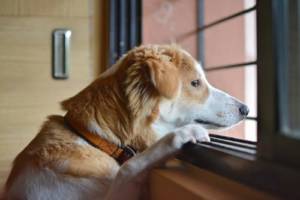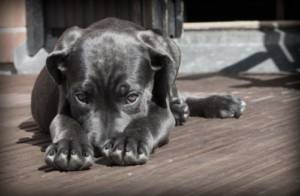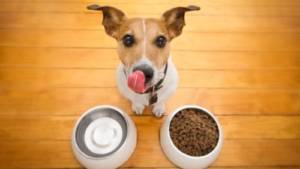Taking care of pets can be a lot of hard work. It’s not easy to understand what your pooch may be saying to you due to a rather large communication barrier of language. A big question on every worried dog-owner’s mind is how long can a dog go without eating? Common and important, considering one of the foremost signs of a dog being sick is their loss in appetite.
Healthy dogs have been known to go roughly 5 days without food, and around 2 days without any water intake. A younger and fitter dog may fare better than an older and bigger one while how healthy a dog remains generally is also a point of differentiation. However, you should not wait 3-4 days before you finally take action and check with a vet on the first moment of concern.

Dogs are happy creatures who have their world limited to you, your home and wherever you may take them. They rarely get to make decisions for themselves as you are their caretaker, god, parent, or whatever you like to call yourself – we don’t judge. They don’t have voices, which means no orders, requests or conversations to tell you what they need or what they’re going through.
As a pet parent, you need to know your dog enough to understand if they’re in any kind of discomfort or pain, or if they’re happy or content. This comes with months of a deeper understanding you may have with your own pet. If you notice your dog being off from their usual behavior, there might be something wrong going on. If your dog isn’t their cheery self, is lazy and lethargic or if they refuse to eat then it might be time to take a more thorough look at their health and well-being.
Being off-color is not necessarily a sign of sickness or poor health, but as you already know from experience, it’s always better to be safe rather than sorry. Being late to notice when things start to go downhill is definitely not the best start you could have had.
How Long Can A Dog Go Without Food When Sick?
As a general rule of thumb, food should not be withheld from a sick dog unless specified otherwise by a veterinarian. It isn’t a cause for concern if a sick dog is without food for 48 hours, however, in case the reluctance lasts for longer than that, a trip to the vet will do you more good than harm.
A dog that is healthy is usually happy, active, hungry for food and in control of their body. However, when your favorite child is sick, it can get tense and difficult for your dog to enjoy and perform the same activities that they would usually do if they were fully fit. Dogs have a susceptible tummy and it cannot be trusted to process everything that your dog may intake, food or otherwise.
If it’s just an upset tummy you’re dealing with, it’s no biggie if your dog refuses the usual food for a day. But if it goes on for longer than a day then you may need to figure out the reason why this is happening. Taking your dog to the vet is a sure-shot way of finding out the anomaly rather than guessing it yourself.
What are the signs my dog may be sick?
A dog may not be able to tell you it’s sick, but he may show it to you with signs and symptoms. After all, you can only start repairing once you know something is wrong. Here are some common symptoms of a dog that is sick –
- Bad Breath or excessive drooling that does not stop for more than a few moments.
- Disinterest in usual activities of joy and pleasure.
- Difficulty in movement or resting.
- Sneezing, coughing, or labored breathing.
- Dry skin/eyes/nose.
- Change in appetite.
- Lumps, soreness, disruptive bowel movements.
Taking Care Of A Sick Dog
Taking care of your best bud when they’re sick is important as it can help speed up their recovery as well as save you some serious money on medical bills. Some things to keep in mind while caring for a sick dog are to understand their needs at this moment of weakness. You can adjust their rest and exercise schedule based on how high their spirits are and however the vet recommends you to do so. A sick dog is also susceptible to tummy upsets which is why you should keep your dog on a strict diet and monitor food-water intake.
A sick dog will heal much faster in a safe and comfortable environment free from any distractions in the house. A weakened immune system may also need cleaner food and housing to prevent any more sickness or infections.
Here is a helpful video with easy steps and general know-how.
How Long Can A Dog Go Without Eating Food With Cancer
Being there for your dog when they’re down with a serious condition such as cancer is essential. It can be tough for you and your schedule, so you can only imagine how painful it must be for your best bud. Cancer in dogs is fairly common, and usually happens when the dog grows older and their immune system weakens.
The most common attacks of cancerous tumors on a dog’s body are the skin, the breast(most common in female dogs), and the digestive system. These tumors are what eventually cause the disease and by lumping around organs in the body and impairing their functioning. The possibilities for treatment are highly dependent on the type of cancer and it’s severity on detection.
A dog diagnosed with cancer is a sensitive case and can be mostly fine without eating food for roughly 2 days. In case the dog still refuses to eat, it is highly recommended to see a vet about the dietary intake of the dog as well as the methods to feed as a refusal to eat food may be a sign of the poor guy giving up. After a dog has been diagnosed, the diet restrictions that are set should be followed strictly while keeping a check on the excretions so that nothing off-cue happens.
In case you haven’t been to the vet’s clinic and are worried if your dog may be showing signs of cancer, these are the top symptoms to look for.
Symptoms –
- Loss of appetite.
- Weight loss despite normal food intake.
- Lethargy and laziness are more than usual.
- Difficulty in breathing.
- Visible discomfort and pain.
- Recurrent digestion difficulties.
- Limping.
- The appearance of lumps and/or soreness in the body.
Prevention –
We get it, there are not many worse feelings than getting to know your pup has cancer and that you could not prevent it from happening to them. In reality, there are only some methods that have been known to prevent the occurence of cancerous cells in a dog’s body and even then, you cannot be fully sure.
A healthy lifestyle for your dog along with a clean and hygienic environment are obvious measures you can take.
It is known that some types of breeds are more at risk to be diagnosed with certain types of cancer statistically. In female dogs, spaying them before they turn two years old can help reduce the risk of breast tumors. There are unfortunately no apparent links between diet and lifestyle that may cause cancer as of now.

Cause –
Cancer in dogs is caused by malignant tumors whose uncontrolled growth can lead to severe forms of cancer. These tumors often form lumps around the organ that they affect, eventually impairing the ability of the organ to function normally and in some cases, even spread to other body parts.
Cure –
There are some types of treatments available for cancerous tumors such as surgery, but surgery may only provide relief if the lump is isolated and hasn’t spread to other parts. It is very difficult to operate surgically on dogs if the tumor is spreading inwards so a lot actually depends on the location of the tumor.
Among the three types of treatment namely – surgery, radiotherapy and chemotherapy, surgery is chosen to remove the tumors present on the skin or distinct internal growths. Chemotherapy is another type of treatment which isn’t used to cure cancer, but rather slow down the growth of the tumor cells, usually post-surgical removal of the tumor. Another use of this technique is in case of leukaemia which can’t be removed surgically.
Radiotherapy is one of the rarer types of treatments that don’t necessarily cure cancer but hinder its growth. It is a time and money-intensive method that does not guarantee anything.
How Long Can A Dog Go Without Eating With Pancreatitis?
There’s a tiny little organs nested between the stomach and the small intestine of your pup called the pancreas. That’s right, the same one you have on you. It aids in the digestion of food and blood sugar regulation of your dog’s body, but it is also the place where one of the most common diseases known to dogs occur. Pancreatitis is the occurrence of an inflamed pancreas and it can be either acute or chronic.
A dog with pancreatitis may experience pain and irritation on their abdominal parts as well as nausea among other things. Their suffering can be decreased with the help of medication and care in these moments of distress.
It is sometimes even recommended by vets to not give food or water for a day in order to give the pancreas a rest. Still, it is not recommended to let a dog with pancreatitis to go for more than 3 days without food, unless specified by a certified professional.
Some breeds such as cocker spaniels, mini schnauzers, dachshunds, poodles and Yorkshire terriers are more exposed to acute or chronic pancreatitis than other breeds due to internal positioning of the pancreas in their bodies.
Symptoms –
As with other illnesses in dogs, it is imperative that you pay attention to your dog and their behavior. Anything unusual may be a sign of distress and/or pain that your voice-less partner may be going through. Look out for signs that your dog may use to let you know they aren’t feeling good.
- If a dog starts showing signs of abdominal pain while lying down or standing up.
- Severe pancreatitis often results in a loss of appetite, which is also a symptom for most dog diseases.
- Sickness and excessive lethargy to do basic tasks.
- Diarrhoea and an irritable bowel are obvious, explicit signs as well.
- In case of milder form attacks, dogs may pump up their rear end up in the air while their head lies on the surface.
- Dehydration and difficulties in urination can be a big sign the dog is unwell.

Causes –
There is no exact cause of pancreatitis, whether acute or chronic and that makes it that much more difficult to prevent it. A huge risk lies in letting your dog go on scavenger hunts when the dog may intake some substances that can severely impact the functioning of the pancreas. Acute attacks of pancreatitis can occur when a dog eats foods that have high-fat content.
In some cases, severe trauma or surgical operations are also known to have triggered the condition. Infections like Leishmania and high triglyceride content in the blood can be listed as factors that increase the risk of pancreatitis.
Prevention –
While there is no way to guarantee that your dog will not come down with pancreatitis, there are some steps that you can take to ensure you do your best. It is recommended to follow nutritional recommendations given by your vet and to give a diet that is not rich in high-fat foods. It is also advised to not let your dog become obese and overweight as it can strain the pancreas as well. Giving your dog table scraps isn’t recommended at all as every dog doesn’t take to human food well enough. And remember, no garbage scavenging!
Cure –
The milder forms of pancreatitis can be cured and the dogs can make full recoveries with restrictions on diet and nursing care. In cases of more severe pancreatitis, the vet will likely pinpoint a cause and start treating for that specifically. Otherwise, supportive care and monitoring are provided along with pain relief medications to relieve the pain in the abdominal areas.
It may be recommended by the vet to not give the dog any food or water in order to let the pancreas relax. Intravenous fluids are also administered for maintaining electrolyte balances.
How Long Can A Dog Go Without Eating Post-surgery?
It is very normal and common for dogs to refuse to eat their usual food after surgery. They have been through a lot of changes and bodily stress, so it is okay if they show a little hesitation in eating normal again. Regular is scary, after all. Don’t worry, he’ll get over it.

Post-surgery it’s okay for dogs to skip meals for a day or two and do not warrant much concern. In extreme cases, dogs may even go without food for 3 days before their health starts seriously deteriorating. In any scenario, it is still recommended to be in contact with your vet to understand what your dog may be going through and would be needing.
There’s no need to panic over how to take care of your precious pup, as your vet should tell you every detail about that, post-surgery. Still, here is a handy list to go by.
Do’s –
- Dogs can be rather lethargic and tired after the stress of surgery so it is recommended to let them rest and recover.
- Get a written list of specific instructions from your veterinarian.
- Make the resting place of the dog as comfortable as you can with blankets and bedding.
- Outdoor activities should be restricted to allow the dog to heal the wound.
- Maintain a hygienic and clean environment for the dog to remain in while they recover to minimise the risk of infections or complications.
- Consult your surgical vet on the diet that should be administered in the first few weeks after the surgery.
- Make sure to give the medications and the drugs that your dog is prescribed on regular intervals to help them remain on the road to recovery.
Don’t –
- Don’t let your puppy-friend scratch, lick or bite the place where the incision was made as it can lead to serious infections and a repeat in the surgical procedure.
- Do not use alcohol or any such substances to clean the incision area if it gets crusty or dirty. It can be cleaned gently by wiping it with a towel and lukewarm water.
- Do not let the dog make too much movement and do not let the dog jump or make any sudden movements that may hurt them eventually.
- Before treating your dog with treats and eatables, check with your vet on the safety of whatever you’re giving to your dog.
- Do not assume anything and call your vet if you’re unsure about anything.
Here is a helpful video on How To Take Care Of Dogs Post-surgery At Home
Conclusion –
In the end, it is important to remember that while dogs can go 5 days without eating, you shouldn’t wait that long before consulting a medical professional on this. Dogs are precious and fragile which makes it even more important to take care of them more intensely. Always keep an eye out for any behavioural or physical changes.
Click edit button to change this text. Lorem ipsum dolor sit amet, consectetur adipiscing elit. Ut elit tellus, luctus nec ullamcorper mattis, pulvinar dapibus leo.
Source –
https://petsofun.com/how-long-can-a-dog-go-without-eating/
